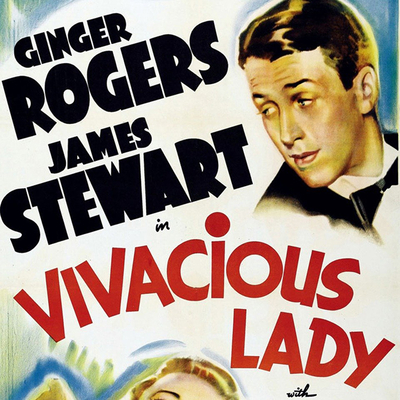There comes a point in every classic film fan's life when you realize you underestimated Ginger Rogers. You never, of course, diminished her talent, especially as Fred Astaire's dance partner over their nine or so RKO musicals in the '30s. But it's with a slight sense of shame that you realize that she was always far more than the second half of an onscreen entity known as "Fred and Ginger".
Because her filmography provides so much evidence of her star power at a glance: Stage Door, Bachelor Mother, Primrose Path, Kitty Foyle, Roxie Hart, The Major and the Minor, I'll Be Seeing You, Storm Warning and Monkey Business taken together are evidence of a career that makes her few years as half of a dance partnership more like a footnote. Or would, if those RKO musicals hadn't been so utterly iconic, then and now.
And because Rogers did such a fine job as a screwball comedy heroine. Perhaps not as perfect as, say, Carole Lombard or Claudette Colbert, but at least as good as Irene Dunne or Jean Arthur. Rogers' persona allowed her to wisecrack and play hard to get as much as any other screwball heroine, but our collective memories of her as the fated conquest at the end of Fred Astaire's light-footed pursuit somehow overshadow this essential fact about Rogers onscreen.
Probably the best example of this is Vivacious Lady (1938), the kind of comedy George Stevens was known for until World War Two turned him into a more ponderous director. Perhaps some of us remember it as a lesser film in Jimmy Stewart's filmography, made when he was just emerging from second billing. (Rogers was by far the bigger star at the time.) It certainly never makes the top tier of lists of great screwball comedies, which is why fifty years passed after learning about the picture before I finally sat down and watched it.
There's certainly nothing anomalous about the film's plot; it hits several tried-and-true tropes of screwball comedy during its brisk 90-minute runtime. And it begins by setting up the reliable "professor meets showgirl" scenario that Howard Hawks and Billy Wilder would polish to perfection with Ball of Fire (1941).
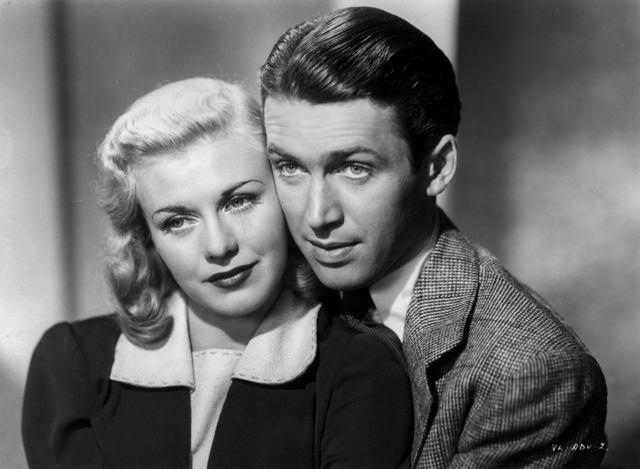
Botany professor Peter Morgan Jr. (Stewart) is in New York City on a quest to extricate his playboy cousin Keith (James Ellison) from the consequences of his latest bender, which inevitably end with a situation involving a singer or dancer. He finds his cousin in white tie at a table by a nightclub's floorshow, waiting for the chorus girls to finish their number so the new love of his life can do her act for the night.
Stiff, stolid Peter is an old hand at this, and he manages to work around the club's indifferent staff (including Jack Carson in a small role as the maître d') to set up Keith's exit from the club. But before he can affect the rescue, he catches a number by Francey (Rogers), the club's star singer. Like any young, unworldly square he falls for her utterly, and instead of whisking cousin Keith off to the train station he escapes into the Manhattan night with Francey, who for some reason crucial nowhere except in a screwball comedy falls for the babbling brainiac and marries him the next morning.
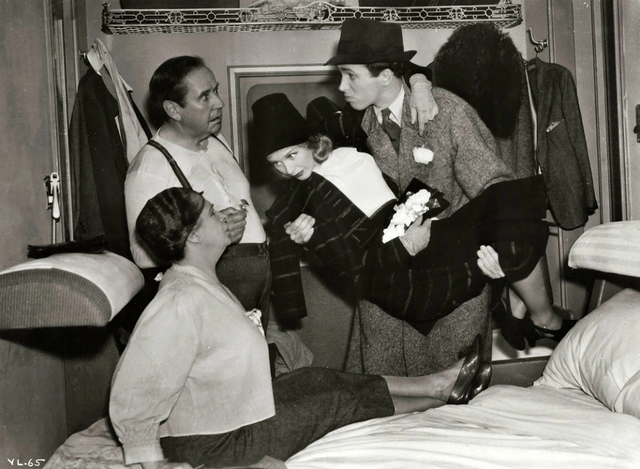
On the train back home to meet his family, they find a hungover Keith, who takes Peter's usurpation of his beloved with remarkable grace and ends up a bemused but willing accessory to everything that comes afterward. Because the real obstacle in the newlyweds' quest to spend their first post-nuptial night together are Peter's parents – delicate, high-strung Martha (Beulah Bondi) and self-important blowhard Peter Morgan Sr. (Charles Coburn).
Coburn makes regular and reliable appearances in this column: he was the fun grandpa in Heaven Can Wait (1943), a jolly business tycoon in The More the Merrier (1943) and a harsher one in The Devil and Miss Jones (1941). His stock in trade as a character actor was the paterfamilias, plutocrat and authority figure, explored in every possible variation, and his appearance in nearly anything elevates the proceedings.
His Prof. Morgan Sr. is the president of the private university where Peter teaches, founded by Peter's grandfather, and the apparent social and cultural hub of Old Sharon, the stuffy college town with which it shares a name. He's also a bully who has managed to cow and control his son his whole life, so the young man is terrified to tell him about his impetuous decision, especially when Morgan Sr. claps eyes on Francey at the train station and calls her a "blonde thing."
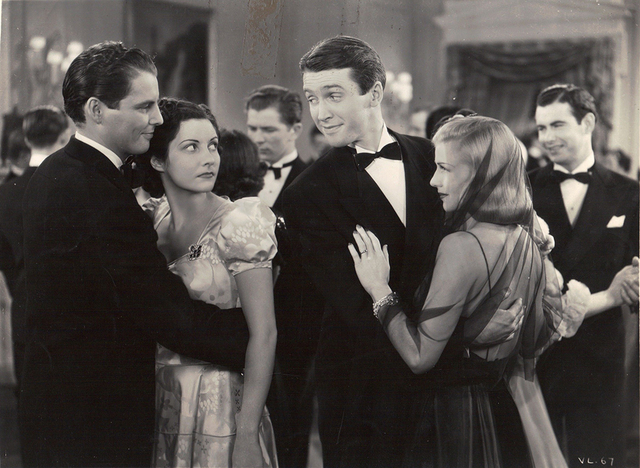
Francey is forced to take part in a hastily-created charade that makes her a new student at Old Sharon; Cousin Keith gamely puts her up in his apartment – he even summons up a wedding cake from the ether – before Francey takes up residence in a women-only apartment building. (Franklin Pangborn plays the building manager, part of a superb cast of supporting actors that includes Hattie McDaniel, Grady Sutton and Willie Best.)
Put-upon Peter was a great role for Stewart to take in the year when You Can't Take It with You would make him a star. The trademark Stewart stammer fits perfectly with Peter's tentative manner, and his issues with families and father figures would resonate through so many of the roles he played as a young man, in films like You Can't Take It with You, Made for Each Other, Mr. Smith Goes to Washington, The Shop Around the Corner, Pot o' Gold and It's a Wonderful Life.
But it almost didn't happen, as Stewart fell ill four days after production began on the picture in April of 1937. Shooting was put on hold while he recuperated and then had to fulfill a commitment to co-star in the MGM western Of Human Hearts, and by the time he returned to the set at the end of 1937, Coburn and Bondi had taken the roles originally cast with Donald Crisp and Fay Bainter.
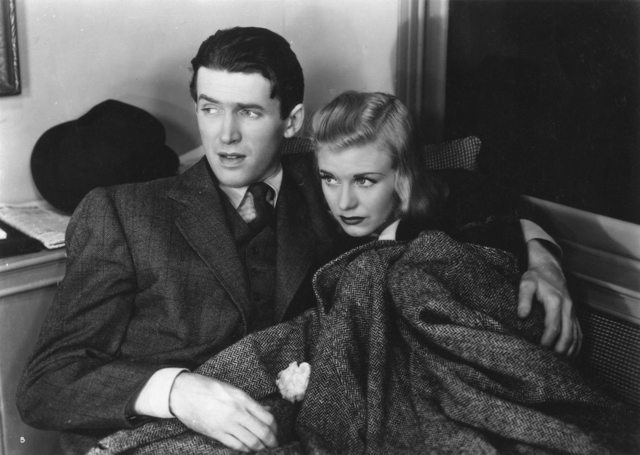
He plays the milquetoast young professor too well, and even though another one of Stewart's trademarks – his sudden outbursts of temper and defiance, held in check until he's pushed too far – is also key to the film's plot, it's more plausible to imagine Francey being better suited to easygoing Cousin Keith. But Rogers and Stewart were dating at the time, so there's plenty of onscreen chemistry between the stars. (Rogers and Stevens had an affair the year before making the film; it must have been an interesting set.)
Vivacious Lady is a great exemplar of screwball comedy's merrily louche tone, and the way it sublimated sex into plot and motivation during the heyday of the Production Code. The whole plot is, after all, about two young people trying to find the time and privacy to consummate their marriage.
In one hilarious scene, Peter and Francey steal away to what he presumes is a quiet spot – a boathouse on campus at night. But when they ease their way in the dark into a motorboat tied up at the dock, they discover that not only is the other half of the boat occupied by another couple, but that every dinghy and canoe in the building, whether sitting in the water or hanging from the rafters, is filled with student couples busy with the same objective.
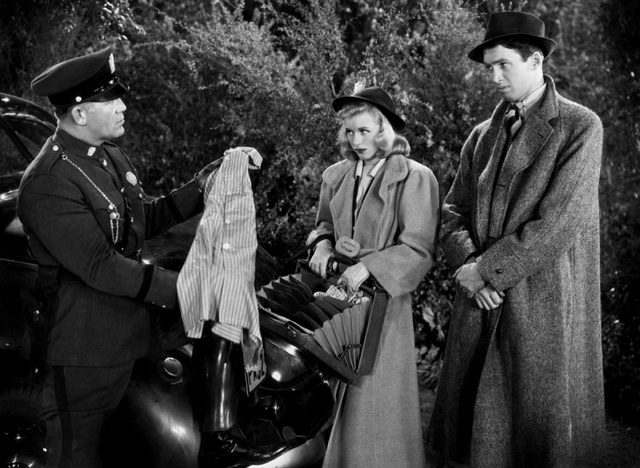
The college setting serves to amplify the hormonal slow burn: in a short essay on the picture on Pop Matters, Michael Barrett writes that "the plot is driven by frustration and the constant titillation of sexual promise. Morgan's students in particular are a randy lot, with both men and women whistling at each other and knowing the score."
To underline the shared agenda of the film's stymied lovers, there's a running gag about murphy beds and railway sleeper bunks falling out of walls. You can almost feel your ribs being nudged by a sharp elbow.
Screwball heroines are almost inevitably an agent of chaos, bringing welcome disorder and change into the lives of the male protagonists, and Francey is no exception. Hoping to announce his marriage to his parents at the college prom, Peter has Cousin Keith bring her as his date, while Peter has his attention monopolized by Helen (Frances Mercer), a socialite chosen as a suitable mate by his father, and who still isn't aware that, as far as Peter is concerned, they're no longer an item.
Francey shows up in a showstopping ensemble of sheer black, complete with veil, and meets Peter's mother in the ladies' room, smoking a cigarette while adjusting her stockings. She shares a smoke with the older woman, who's conspicuously less neurasthenic when she's away from her son and husband.
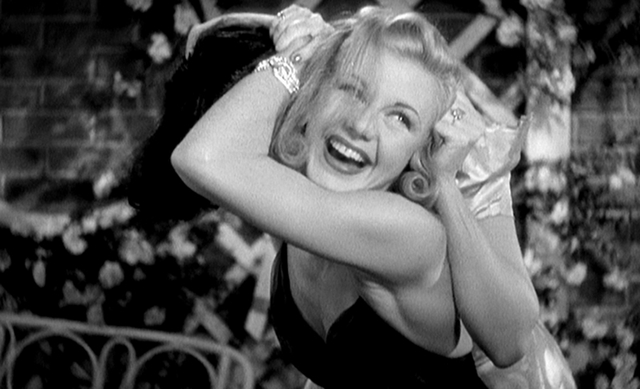
Later Francey and Helen end up sharing words in the garden outside the party, which escalates with slaps into a catfight that Peter and his father interrupt mid-headlock, to Francey's cackling amusement. Helen plays dirty with a hairpin to the posterior, and Francey responds with a brutal over-the-shoulder toss to the ground. In the ensuing fracas Peter's bride decks his father with a stray punch.
You'd never call a classic screwball heroine an innocent – though Carole Lombard might have toyed with a blithe cluelessness in a few of her roles – but their worldliness had to be measured on a sliding scale. Jean Arthur might have been the most virtuous, and though none of them could signal their intimate knowledge of what went on outside the censor's purview like Barbara Stanwyck, Rogers' way with a wisecrack lets you know she's no naïf.
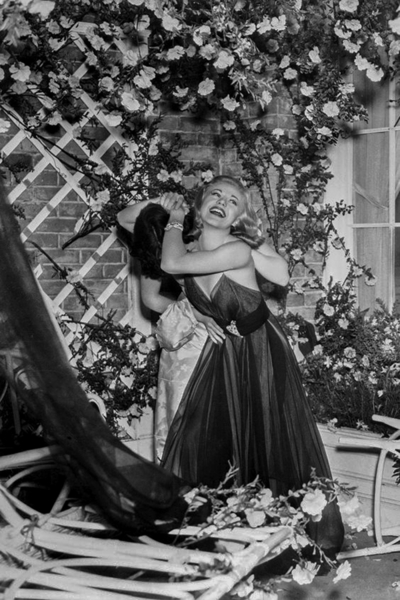
Writing about Rogers in Romantic Comedy in Hollywood from Lubitsch to Sturges, James Harvey notes that Rogers' persona was constantly changing from film to film during the heyday of her career, in a way that Myrna Loy's, for instance, was not. She was the "wise girl," more often than not – her Jean in Stage Door (1937) is almost never bested in a screen full of women cracking wise – and Rogers could retreat into this knowing cynicism at almost any time in her career. But George Stevens, Harvey says, was trying to "turn her into June Allyson".
Harvey notes that "there are no tough girls in any of Stevens' films" and that it seemed opportune with Vivacious Lady to "turn her into a sweet one, without astringency or sarcasm." And though Francey "is a nightclub singer, she in unimpeachably ladylike – except when (as quite often) she is girlish. She even does baby talk: 'I'll be home as soon as Papa learns me about all the flowers,' she says, batting her eyes."
"The Rogers persona is 'opened up' in this film – no guardedness at all. She is revealed to be without suspicion or rancor or wit, all wide-eyed and glowing, all compliant warm femininity. It's a style, including the baby talk, that she would favor more and more as her career went on. And it's hopeless. Whenever she tries to be 'starry' or radiant in any conventional way, all that really registers is the falsity and the effort."
I think Harvey is being far too harsh with his judgment; it reads like he has an ideal for Rogers onscreen and that this film, for whatever reason, didn't meet his expectations. There's certainly nothing "unimpeachably ladylike" about how Francey handles Helen in their fight. But it's certainly true that, under various directors, Rogers is presented in very different ways as the '30s turned into the '40s; just compare the self-confident Francey to the sullen Mary in Gregory La Cava's Fifth Avenue Girl a year later.
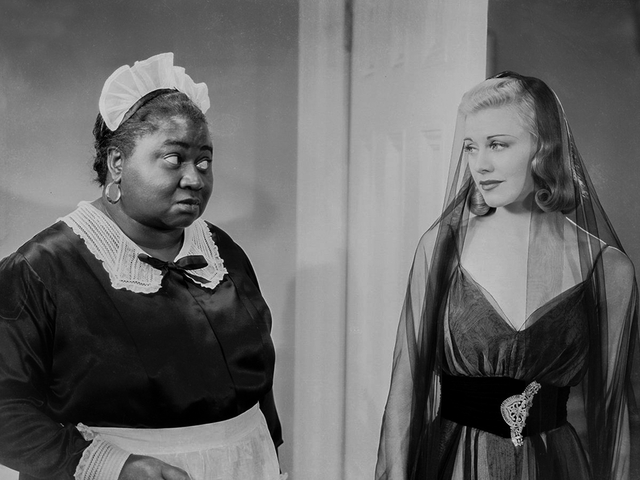
In any case there's a lot of joy to be found in watching Rogers' Francey wreak havoc on the self-satisfied world of Old Sharon as presided over by Coburn's Prof. Morgan. The old man comports himself with the bluster of a robber baron minus the riches, expecting deference from everyone, including his son. He has inherited his position the way a Rockefeller inherits their wealth, and expects his son to do the same, provided he follows the rules he arbitrarily sets for him.
He only shows deference to the college's benefactors, especially the one visiting campus as a prelude to making a major donation, and who gets to sit in on one of Peter's classes after the young man decides that he has to destroy his reputation with unseemly behaviour in order to make his father consider him unworthy enough for his showgirl wife.
He drains Cousin Keith's mickey in a storeroom off his laboratory and mixes more intoxicant with the chemistry at hand before giving a short but incoherent lecture, to his father's horror. The donor, on the other hand, finds the sodden display a welcome distraction from Old Sharon's ivy-covered pomposity and, laughing, tells Prof. Morgan that he's got his donation.
Francey is also the catalyst that transforms Martha Morgan's life. When Peter's mother arrives to confront the hussy that she's been told has stolen her son, she learns that Francey is not just his wife but desperate to make the poor boy happy, even if it means leaving him.
Martha reveals that her bouts of "heart trouble" whenever voices are raised is really just a ploy to get her belligerent husband to stop arguing with people; the admission is a relief to her, and she ends up dancing the Big Apple along with Francey and Cousin Keith to the radio while Prof. Morgan looks on aghast. He demands she come along with him; she responds that she's had enough of his bullying and Old Sharon and will be leaving on the next train.
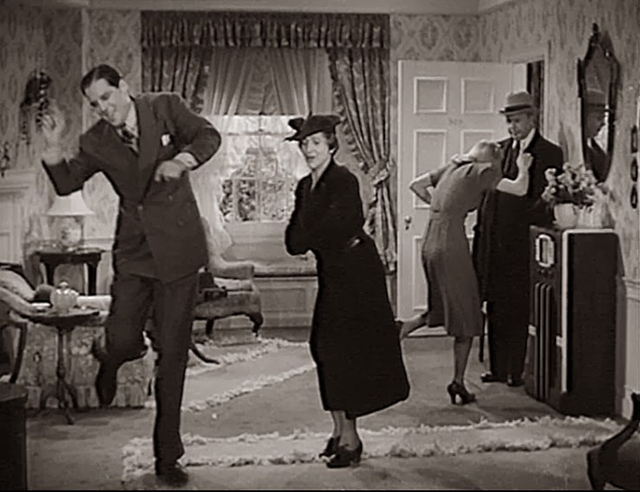
Vivacious Lady is no screwball masterpiece like His Girl Friday or My Man Godfrey, but its standout scenes help it add up to more than the sum of its parts. There's the shot of Stewart, tucked into the frilly coverlet and bed linens of the room he's had the family maid do up in the most feminine style possible, anticipating he'd be spending the night there with his new wife. Alone under the covers with only his face showing, he glares murderously at Cousin Keith while he mocks him.
Hattie McDaniels and Willie Best have great scenes, with Daniels as the ladies' room maid at the prom and Best as a porter on the train that Francey and Martha are riding after leaving their husbands. These kinds of roles are, to be sure, taken with a heaping dose of context and historical hindsight, but they both get a lot out of their brief screentime, with Best in particular stealing his scene from the ladies weeping in adjacent first-class compartments.
"Vivacious" is a word that, like "manners", we don't use much these days, with the predictable result that few people could agree on their definition, if they can venture one at all. (It might be one reason why Vivacious Lady has become so undeservedly obscure.) My 1995 Concise OED defines it as "lively, sprightly, animated," while my even older 1959 Webster's sums it up as "active; spirited and full of life." (Is it even worth musing that an increasingly demoralized society might have no use for a word like "vivacious"?)
Whatever experiments might have been going on with Ginger Rogers' onscreen persona at the time, Stevens' film wouldn't work at all if it couldn't rely on how the actress could reliably meet or exceed the charisma of her male co-stars, whether they were Fred Astaire or Jimmy Stewart.
Mark Steyn Club members can let Rick know what they think by logging in and sharing in the comments below, as access to the comments section is one of many benefits that comes along with membership in the Mark Steyn Club.


